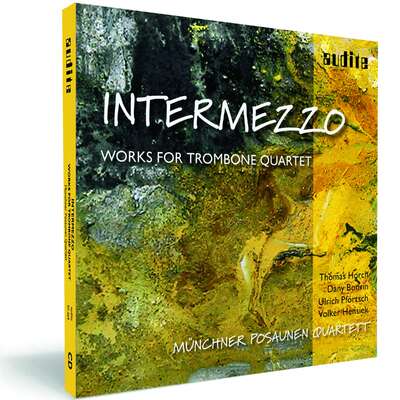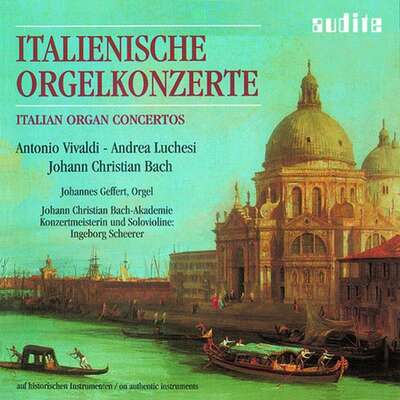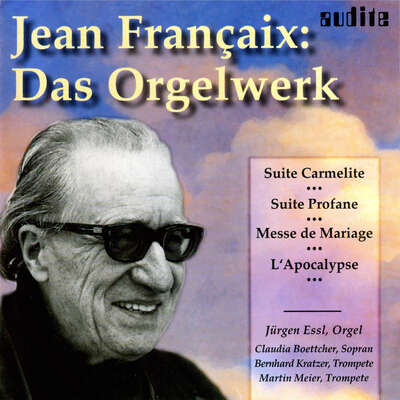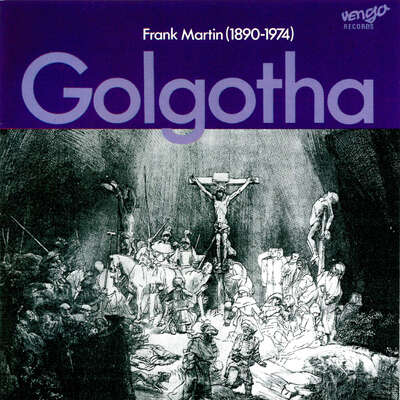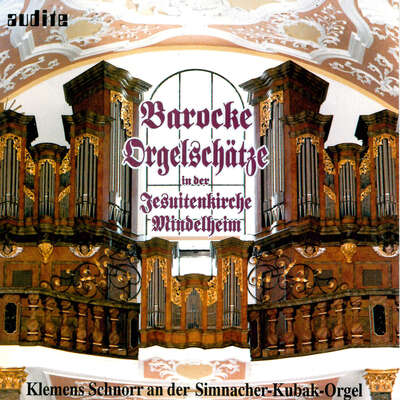
What Dialogi be is known to everyone: for Dialogus means a conversation, as when one answers the other’s questions, alternating one after the other like in Choros. Thus can also the Echo be here referred to. Michael Praetorius, Syntagma Musicum III, 1619 The rhetorical fundamental...more
"As is the norm with Audite, the documentation is first class. There was, in my case, a restorative effect in listening to this lovely recording, the fourth in a series from Muri. Very well worth investigating!" (Audiophile Audition)
Details
| Echo & Risposta – Virtuoso instrumental music from the galleries of the Abbey Church of Muri | |
| article number: | 92.572 |
|---|---|
| EAN barcode: | 4022143925725 |
| price group: | ACX |
| release date: | 18. September 2009 |
| total time: | 73 min. |
Bonus Material
Informationen
What Dialogi be is known to everyone: for Dialogus means a conversation, as when one answers the other’s questions, alternating one after the other like in Choros. Thus can also the Echo be here referred to.
Michael Praetorius, Syntagma Musicum III, 1619
The rhetorical fundamental gestures which characterise the instrumental compositions of the 16th and 17th centuries are shown most impressively in the echo and response dialogues of spatially separated choirs. At St. Mark’s in Venice, where several musicians’ galleries were available, this multi-choir format reached a highpoint with Giovanni Gabrieli towards the end of the sixteenth century and gained stylistic influence well beyond Italy. The majority of works included in this recording date from the 20s and 30s of the seicento, when composers enjoyed their newfound means of expression and freedom all the more. This music is characterized by exuberant virtuosity and joy of playing, as well as a programmatic accentuation of the then modern style.
The four galleries of the Abbey Church of Muri offer optimal conditions for multi-choral music. So as to include the historical organs of the church, two cornettos were produced whose pitch exactly matches that of the Bossard organs of the Abbey Church of Muri. The present recording is the first sound documentation of this essential musical practice of the Abbey Church of Muri.
Les Cornets Noirs was founded by Gebhard David and Bork-Frithjof Smith in 1997. The group’s main interest lies in the solo and ensemble literature for the instrument which gives the group its name: the cornetto (cornetto/ cornet). In the year 2000 Les Cornets Noirs were prize winners in the concours musica antique at the Festival van Vlaanderen Brugge. Since then, the ensemble has performed regularly in Switzerland, Austria, the Czech Republic, Poland, Germany, Luxemburg, France, Italy, and Portugal, both with their own programmes and together with vocal groups for the performance of large-scale Early Baroque works
Reviews
ORF Ö1
| Mittwoch, 20. Juni 2012, 13:00 Uhr | Gustav Danzinger | June 20, 2012
Der wunderbare Zinkenklang
Les Cornets Noirs in der Klosterkirche Muri
Als vor rund 40 Jahren die ersten Zinkenisten in den Ensembles für Renaissance- und Barockmusik auftauchten, war die Verblüffung ob des KlangesMehr lesen
Toccata | Heft 53, Nr. 3/2011 (Mai-Juni 2011) | Johan van Veen | May 2, 2011 'Im Maien – Musik des 16. und 17. Jahrhunderts für Virginal und Zink'. Christian Brembeck (Virginal, Cembalo), Thomas Hasselbeck (Zink) Cantate – C 58043 (2009; 62') 'Echo & Risposta – Virtuose Instrumentalmusik von den Gallerien der Abteikirche zu Muri'. Les Cornets Noirs Audite – 92.572 (2008; 74')
'Im Maien' heisst die CD von Christian Brembeck und Thomas Hasselbeck. DerMehr lesen
musica Dei donum | 01.03.2011 | March 1, 2011
The early 17th century was a musically exciting time, in particular inMehr lesen
Early Music Review | February 2011 | Roberto Giuliani | February 1, 2011 Instrumental music of the early 17th century
The three CDs under review, which will be discussed in the chronological order of their recording, encompass a broad spectrum of early 17th-centuryMehr lesen
The Contest of Apollo and Pan: An anthology of instrumental music by Castello and his contemporaries (Chandos CHAN 0756, rec 2004, 73’) demonstrates the contrast between wind and stringed instruments and between the wild and sublime. Pan, with his prodigious agility, sexually beguiling, rugged and fast-moving, gladdens the hearts of all (Greek etymology) and is often depicted with a syrinx. Apollo, on Mount Parnassus, is represented as the God of music and poetry, and even has a herd sold to Hermes, who had invented the lyre, to take possession of the instrument. With his lyre, Apollo won not only the musical duel with Pan (thus Ovid’s Metamorphosis tale) but also with Marsyas, who was skinned after having been hung from a pine tree. In this CD, the battle is far less grim, but despite the widespread presence of writing for the violin, the sound of the dulcian is the really interesting aspect of this recording, which is built around unusual repertory for bassoon and violin; the contrasts in timbre build on the natural contrasts of the Baroque idiom.
The ensemble Apollo & Pan, winners of the 2001 Early Music Network International Young Artist’s Competition, and now making their debut recording, address the limitations of the repertory available for this combination of instruments by adding a second violin. This enables them to approach a series of sonatas (nos. 10, 4, 7, 8 and 9, in that order) from Book II (1629) by Dario Castello, a wind player at St Mark’s, Venice. A collection of early 17th-century instrumental variations is added to these sonatas: Chiacona op. 3 by Merula; Sonata and Balletto op. 22 no. 1 by Marini, Sinfonia Brando Gagliarda and Corrrente from Book IV by Buonamente; the famous Toccata no. 1 from Book II and Capriccio sull’aria di Ruggiero by Frescobaldi; a Sonata from Book IV by Rossi; Ancor che col partire by De Rore (followed by Spadi da Faenza’s version); and a Sonata by Turini. The time-span from 1621 to 1655 is comprehensively covered. Within this programme, dulcian player Sally Holman can fully demonstrate her skill. This is especially evident in the Sonata no. 7 by Bertoli (a passacaglia bass is entrusted to her instrument, with divisions becoming increasingly virtuosic), in the Chiacona by Merula and in the Balletto by Marini. Within this creative collection of anthologies, perhaps the least interesting tracks are those involving music by Castello; these collections of virtuoso instrumental music are in fact less important for what they represent about compositional practice than for the dissemination that the composer was assured by several reprints; a similar process is also reflected in the choices of repertory on this CD, another element in the chain of transmission.
Giovanni Gabrieli and his contemporaries: Canzoni per sonare con ogni sorte di stromenti (Venice, 1608) (SFZ SFZM 0209, rec 2007, 67’) contains samples of the work of Venetian publisher Alessandro Raverii, cousin of Gardano. These cover a short span, from 1606 to 1609, but the inclusion of his typographic mark, an eagle carrying in its beak the words 'Aeternitati', was prophetic, immortalizing amongst other things his collection Canzoni per sonare con ogni sorte di strumenti a 4, 5 e 8 con il suo Basso generale per l’org. Nuovamente raccolte da diversi Eccellentissimi Musici (Venice, 1608). Of the 36 compositions originally included in the collection, the ensemble His Majestys Sagbutts & Cornetts has selected 25, of which the majority are by Giovanni Gabrieli: he is represented by the 6 Canzoni (the entire set of those in the collection). Following those, and belonging to different generations and originating from Venice, Brescia and Ferrara, are three compositions by Frescobaldi and Guami, two by Antegnati, Lappi, Massaino and Merulo and one each by Bartolini, Chilese, Grillo, Luzzaschi and Maschera. This is a pity, because the CD could have contained even more music, especially compositions by Chilese; we know him only through the three pieces in this anthology printed by Raverii, and it would therefore have been interesting to listen to them all.
The editorial project undertaken by the ensemble is commendable, but the difficulty of encompassing the music of a range of contemporary composers is also reflected by the cover of the CD: this highlights 'Canzoni per sonare' and 'Giovanni Gabrieli' whilst 'and his contemporaries' is given in small characters. This suggests a legitimate compromise between the obligation to inform and the need not to discourage the buyer; but an explicit reference to the miscellaneous character of the collection would have been preferable. This approach does not alter the historical and aesthetic value of the CD, where the variety of types of instrumentation and the ability of the performers sustains the listener’s attention, despite the fact that this repertory may appear too homogeneous, at least at first hearing. Even the sound-quality of the recording, made in the Church of St John the Evangelist in London, avoids this danger of homogeneity, bringing out as it does the different instruments and instrumental combinations. However, in some cases, for example, tracks 1, 8 and 11, the final chord is not allowed to resonate for long enough, being interrupting in an unnatural manner.
The qualities of His Majestys Sagbutts & Cornetts have been established for many years, particularly in relation to sound-quality and agility in the improvised ornamentations. The ensemble generates a real sensation of splendour through the dialogues between wind and string groups. Contributing further to the excellence of the recording are the ensembles the Purcell String Quartet, and the lute group Chordophony, which offers a stimulating performance of Canzon Vigesimasesta 'La Negrona' à 8 by Lappi, with the four lutes divided into two choirs; the composition is written antiphonally for high and low choirs. Also noteworthy is the performance of new versions of pieces performed previously, but using different instruments: a case in point is Canzon Quartadecima 'Capricio', a 4 by Grillo, first assigned to the organ and then to the violin consort. The booklet specifies the instrumental assembly of each item. The abbreviations of the performers suffer in some cases from printing errors: GC, for example, is Gary Cooper (harpsichord and organ), not mentioned in the list of performers on p. 7.
The scoring combinations imply careful thought. For example, the interpretation of Canzon Trigesimaquarta, à 8, per Quattro viole, e quattro Chiteroni, ò Leuti by Massaino involves the string quartet (in preference to violas da gamba) and lute quartet (instead of the chitarrones). In line with the practice of the time, this choice also reflects the availability of players where, in the absence of alternatives, one has to make do with who happens to be present. 'So the final scoring of violin and lute consorts was one of personal choice', we read in the note by Jamie Savan (cornett), 'as was our choice of scoring for all the canzonas with unspecified instrumentations. In allocating these pieces to various combinations of wind instruments, bowed and plucked strings, organ or harpsichord, our aim was to create a kaleidoscope of sound, all within the spirit suggested by Raverii’s designation of ogni sorte di stromenti'.
In Echo & Risposta: Virtuoso instrumental music from the galleries of the Abbey Church of Muri (Audite SACD 92.572, rec 2008, 73’) we are again faced with a group focused on a particular segment of Baroque-era production, this time music for cornett, which led its members to unearth rarely performed music, and in a sense to build a repertory. Les Cornets Noirs, prize-winners at the Concours Musica Antiqua at the Festival van Vlaanderen Brugge 2000, orientate this disc towards the 1620s and 30s with their choices of music by Becker, Re, Corradini, Rossi, Gussago, Castello, Riccio, Marini, Viadana, Picchi, Stradella, Scheidt, Sommer and Staden. The effect is of a varied programme, with different atmospheres, with 'echo & risposta', as the title states, a diversity of instrumentation, as facilitated by the skill of the musicians. It is, moreover, commendable to have included works not only by famous authors such as Rossi or Scheidt (whose Echo has a duration of 8’40˝) but also by lesser-known composers.
Of constant importance on the CD itself and in the booklet is the issue of choice and interchanging of instruments (for instance, Sonata a quattro Violini e doi Chitarroni by Rossi). A 'light' ensemble consisting of two cornetts and two organs (Suonata La Golferamma. A 2 cornetti in risposta by Corradini, Canzon a 2 in echo by Riccio) is alternated with the two choir pieces by Becker, Rossi, Picchi and Staden, leading up to the musical magniloquence of Marini, Somer and Scheidt (Canzon Cornetto a 4).
The label Audite is evidently concerned with the quality of the sound (super audio CD, surround sound), and is rightly convinced that the CD should have its own independent aesthetic. The care taken in the preparation of the finished product is considerable, with the booklet including much information on the instruments and on their appropriateness for each item, and about the microphones and technical specifications of the product. The association Freunde der Walls Klosterkirche commissioned the construction of two cornetts (Serge Delmas, Paris, 2005) tuned at the pitch of the two Bossard organs (approximately A = 425), so they can be used in a musical performance that exploits the four galleries of Muri Abbey. This CD provides the first evidence of this practice. 'The Abbey Church of Muri, Switzerland', says the booklet, 'with its four galleries around a large octagonal dome, enables several groups of musicians to be widely spaced, creating unique spatial acoustics. The ensemble Les Cornets Noirs exploits this fantastic building to full effect in an exciting recording of instrumental music from the early Baroque'.
Finally, the booklets accompanying all of these CDs are, as usual, presented in French, English and German, carefully avoiding Italian and thus omitting a sector of the market. This is a bad habit of publishers, particularly if one considers that the composers presented here are almost all Italian and that many have become international figures, as the Italians have become so inattentive to their own musical heritage!
Schweizer Musikzeitung | Nr. 7/8 / Juli/August 2010 | Christoph Greuter | July 1, 2010
Dialogisierende Musik
Echo & Risposta, Virtuose Instrumentalmusik von den Emporen der Klosterkirche Muri. Canzonen und Sonaten von Marini, Rossi, Castello, Viadana u.a. Les Cornets noirs; Johannes Strahl, Markus Märkl, Orgeln. Audite SACD 92.572
Echowirkungen in der Musik, also einander antwortende Stimmen oder Instrumentalgruppen, sind eine typische musikalische Eigenart des 16. und 17.Mehr lesen
Les Cornets noirs sind mit ihren beiden bekannten Zinkenisten Gebhard David und Bork-Frithjof Smith geradezu eine klangliche Offenbarung. Denn während man noch vor wenigen Jahrzehnten glaubte, sich mit Intonationsschwierigkeiten bestimmter Instrumente, zum Beispiel eben des Zinks, definitiv abfinden zu müssen, wirken heute glücklicherweise ganz andere Musikergenerationen im Bereich Alte Musik, die diesbezüglich nichts mehr anbrennen lassen: Nein, die Zinkenisten von Les Cornets noirs wie auch die anderen fabelhaften Musikerpersönlichkeiten an den Blasinstrumenten, Violinen und der Orgel artikulieren musikalisch absolut klar, formen die Musik und bleiben dabei sehr transparent und stets unaufdringlich virtuos. Ihre Musik ist in einen hervorragenden Klangteppich mit Surround Sound eingepackt. Alles in allem eine Ohrenweide erster Güte, die mit über 70 Minuten Einspielzeit dennoch kurzweilig bleibt.
American Record Guide | May-June 2010 | Barry Kilpatrick | May 1, 2010
Les Cornets Noirs (Black Cornettos) offers a program of 17th-Century Italian and German works that include striking examples of echo and responseMehr lesen
Cornetto players Gebhard David and Bork- Frithjof Smith, violinists Amandine Beyer and Cosimo Stawiarski, and bassoonist Adrian Rovatkay are excellent. Sackbut player Franck Poitrineau’s tone quality is quite nasal, something I disliked at first but grew to appreciate as interesting and unusual.
The Basel, Switzerland-based, early-music ensemble performs in the Abbey of Muri, an ancient monastery with an elaborately decorated, 18th-Century church. Two Bossard organs from 1743 are heard here (complete specifications included, as well as registration codes for each piece). Some of the program’s most memorable pieces pit one organ against the other. The fine organists Markus Märkl and Johannes Strobl play Viadana’s ‘Sinfonia La Mantovana’ with penetrating tone and exuberant ornamentation. In Scheidt’s ‘Echo ad manual duplex forte & lene’, melodic passages, chord progressions, and even single chords are played stridently by one, and then imitated with softer tone (and seemingly from a distance) by the other. On and on it goes for almost nine minutes—Scheidt was enjoying himself and was in no hurry.
Pizzicato | N° 200 - 02/2010 | Norbert Tischer | February 1, 2010 Klangerlebnis
Das Ensemble 'Les Cornets Noirs' wurde 1997 gegründet. Das Hauptinteresse der Gruppe gilt der Solo- und Ensembleliteratur des namengebendenMehr lesen
Bei Audite erschien nun die zweite CD der 'Cornets Noirs'. Sie bietet ein abwechslungsreiches Programm mit doppelchöriger Instrumentalmusik des 17. Jahrhunderts, aufgenommen mit den historischen Bossard-Orgeln von 1743 auf den vorderen beiden Musikemporen der Klosterkirche Muri in der Schweiz. Die Surround-Aufnahme ist vorzüglich gelungen und garantiert auf der Mehrkanalanlage ein wunderbares Klangerlebnis, dies nicht zuletzt, weil auch das Ensemble durch eine hohe Klangkultur und ein vitales, aber nie forciertes Musizieren überzeugt.
Fono Forum | Februar 2010 | Matthias Hengelbrock | January 13, 2010 Doppelchörig
Im ausgehenden 16. Jahrhundert erlangten venezianische Musiker, allen voran Giovanni Gabrieli, mit ihren mehrchörigen Vokal- undMehr lesen
Die vorliegende SACD zeichnet den Weg, den die Idee der Doppelchörigkeit von Venedig über Süddeutschland bis nach Hamburg nahm, eindrucksvoll nach. Aufgenommen wurde sie in der Klosterkirche Muri (Schweiz), auf deren einander gegenüberliegenden Seitenemporen zwei Orgeln aus ein und derselben Werkstatt günstige Voraussetzungen für dieses Projekt bieten. Da diese Instrumente aus späterer Zeit (1743) stammen und einen entsprechend anderen Stimmton haben, wurden eigens für das Musizieren in diesem Raum zwei Zinken auf 425 Hz gebaut.
Der Aufwand hat sich gelohnt. Gebhard David und Bork-Frithjof Smith spielen die Zinken mit einer fabelhaften Kantabilität, Amandine Beyer und Cosimo Stawiarksi (Violine) bereichern die Dialoge mit wendigen Diminutionen, Markus Märkl und Johannes Strobl holen sowohl als Continuo- wie auch als Soloorganisten eine Menge aus ihren Instrumenten heraus, und Adrian Rovatkay (Fagott) und Franck Poitrineau (Posaune) lassen einen darüber staunen, mit welcher Virtuosität die Bassinstrumente Anteil am melodischen Geschehen nehmen. Fazit: So unaufdringlich souverän und klanglich ausgereift hat man diese spannende Musik bisher selten gehört.
Aargauer Zeitung | Mittwoch, 4. November 2009 | Christian Berzins | November 4, 2009
Von Muri in die Welt hinaus
Dank dem Kirchenmusiker Johannes Strobl ist die Klosterkirche Muri wie selten zuvor ins Blickfeld der Musikfreunde geraten. Nun legt man zwei neue CDs vor
Bloss nie in einer CD-Besprechung schreiben: „Man könnte ewigMehr lesen
RBB Kulturradio | um 13:30 Uhr am 2. November 2009 | Bernhard Morbach | November 2, 2009
"Echo & Risposta"
Virtuose Instrumentalmusik von den Galerien der Abteien der Abteikirchevon Muri (Schweiz)
1. Niccolò Corradini: Sonata La Golferamma… in risposta [3] 4’09<br /> <br /> CDs mit dem Repertoire der vorliegenden, nämlich instrumentaleMehr lesen
CDs mit dem Repertoire der vorliegenden, nämlich instrumentale Ensemblemusik des 17. Jahrhunderts, gibt es geradezu haufenweise. Was die Interpreten an diesem Repertoire so fasziniert, ist die Freiheit im Bereich der Instrumentation und des Ausdrucks. Und der Hörer von heute ist erstaunt über den Reichtum an Klangfarben und Formen. Ausgehend von Italien wurde diese avantgardistische Kammermusik seit dem frühen 17. Jahrhundert auch in Deutschland populär und es entstand eine geradezu unüberschaubare Anzahl von Kompositionen.
2. Cesario Gussago: Sonata La Leona a 8 (2 Orgeln) [5] 3’09
Ein besonderes Segment innerhalb dieses Repertoirs funktioniert nach dem Echo-Prinzip oder ist eine Frage- und Antwortspiel im Rahmen von vielstimmigen Kompositionen, die doppelchörig organisiert sind. Solche Echo- und Risposta-Kompositionen hat das Ensemble ausgewählt. Diese Musik ist den räumlich musikalischen Gegebenheiten in der Klosterkirche von Muri geradezu auf den Leib geschneidert. Denn dort liegen zwei barocke Orgeln (1743) auf einer Galerie, die den ganzen Kirchenraum umgreift, einander genau gegenüber. Diesen Orgeln nun, auf denen in den Sonaten und Canzonen der Basso continuo ausgeführt wird, sind Instrumentalisten zugeordnet.
3. Giovanni Battista Riccio: Canzon a 2in Echo [7] 3’11
Insgesamt ergibt sich eine Fülle von räumlichen Klangwirkungen, die in hohem Maße faszinieren, besonders freilich dann, wenn man die Mehrkanal-SACD (die auch einen normalen CD-Layer besitzt) auf einer entsprechenden Anlage abhört. Die Spielkultur des Ensembles ist besonders im Hinblick auf Intonation und rhetorischer Affektgestaltung erstklassig. Eine solche wunderbare Synthese von Instrumental- und Raumklang kann man nur selten hören.
4. Lodovico Grossi da Viadana: Canzon francese in risposta [11] 3’37
CDs mit dem Repertoire der vorliegenden, nämlich instrumentale
Audiophile Audition | October 27, 2009 | Peter Joelson | October 27, 2009
Recorded between 4 August and 7 August 2008 at the Abbey Church of Muri,Mehr lesen
Deutschlandfunk | Sonntag,18.10. 2009 um 09:10 Uhr | Rainer Baumgärtner | October 18, 2009
Dem Meister auf der Spur
Mariengesänge von William Byrd
1605 und 1607 erschienen zwei mit 'Gradualia' überschriebene Bände mit lateinischer Kirchenmusik vom großen Komponisten William Byrd. MehrstimmigeMehr lesen
Heute können Sie zwei Veröffentlichungen mit Alter Musik kennen lernen, englische Vokalmusik steht dabei italienischer und deutscher Instrumentalmusik gegenüber. Am Mikrofon begrüßt Sie Rainer Baumgärtner.
Für das Label "audite" hat das Ensemble Les Cornets Noirs unter dem Titel 'Echo e risposta' auf den Emporen der Klosterkirche Muri in der Schweiz virtuose Instrumentalmusik eingespielt, die zumeist in den 20er-Jahren des 17. Jahrhunderts veröffentlicht wurde. Ein wenig früher, in den Jahren 1605 und 1607, erschienen zwei mit 'Gradualia' überschriebene Bände mit lateinischer Kirchenmusik vom großen englischen Komponisten William Byrd. Mehrstimmige Mariengesänge daraus hat das Vokalensemble The Cardinall's Musick neu für das Label Hyperion aufgenommen. Vor 20 Jahren als Studentenchor gegründet, zählt The Cardinall's Musick inzwischen zu den führenden englischen Gesangsformationen im Bereich der Alten Musik. Ihr Gründer und Leiter Andrew Carwood ist daneben auch auf dem prestigeträchtigen Posten des Musikdirektors an der Londoner St.Paul's Cathedral gelandet. Mit seiner jüngsten Veröffentlichung hat das Ensemble ein beeindruckendes Projekt abgeschlossen, die Gesamtaufnahme aller lateinischen Kirchengesänge William Byrds auf zwölf CDs.
1) William Byrd, Beata es, Virgo Maria (Offertorium / Mariae Geburt)
Dies war der Gesang zur Gabenbereitung "Beata es, Virgo Maria-Glücklich bist du, Jungfrau Maria" von William Byrd. Mit Byrd hat sich das Vokalensemble The Cardinall's Musick dem bedeutendsten englischen Komponisten der Spätrenaissance zugewandt. Zeitweilig wirkte er am englischen Königshof und schrieb Musik für den anglikanischen Gottesdienst. Doch seine lateinischen Werke aus der zweiten Hälfte seines Lebens lassen erkennen, dass er ein standhafter Katholik war, der auch in einer Zeit von Repressalien gegen Katholiken seinem Glauben treu blieb. Die meist kurzen Werke aus seinen beiden 'Gradualia'-Bänden konnten als erbauliche Gesänge für den Hausgebrauch benutzt werden (und waren von daher für die Zensur unangreifbar), man konnte sie aber auch in heimlichen katholischen Gottesdiensten einsetzen. The Cardinall's Musick hat die durch Prägnanz und rhythmische Vitalität bestechenden polyphonen Werke für die Einspielung nach Themen gegliedert. Auf der neuen CD präsentiert das Ensemble Kompositionen für drei Kirchenfeste zu Ehren der Jungfrau Maria.
2) William Byrd, Benedicta et venerabilis (Graduale / Mariae Geburt)
Dies war "Benedicta et venerabilis", ein Gesang zur Gabenbereitung aus der Messe am Fest Mariae Geburt. Englische Vokalensembles im Bereich der Alten Musik hatten früher meist den Ruf, technisch hervorragend zu sein, dabei aber oft den emotionalen Moment der Musik außer Acht zu lassen. Die vielfach preisgekrönte Cardinall's Musick überzeugt hingegen mit einem empfindsamen und variablen Stil, der die meisterhaften kleinen Kompositionen William Byrds voll zur Geltung kommen lässt. Dies hört man auch bei seiner Teilvertonung des "Ave Maria- Gegrüßet seist du, Maria", dem bekanntesten Mariengebet.
3) William Byrd, Ave Maria (Offertorium / Mariae Verkündigung)
Zu Lebzeiten William Byrds um 1600 fand der Übergang von der Renaissance zum Barock statt und eine zukunftsweisende Entwicklung im Bereich der Musik war dabei die Emanzipation der Instrumental- von der Vokalmusik. Besonders prägnant ereigneten sich diese Entwicklungen in Italien und das Ensemble Les Cornets Noirs lässt diese auf seiner neuen CD mit markanten Beispielen nachempfinden-zusätzlich verdeutlichen einige deutsche Kompositionen, wie die italienischen Impulse hierzulande aufgenommen wurden.
'Echo e risposta-Echo und Antwort' lautet der Titel der CD, der auf zwei typische Kompositionstechniken der Epoche um 1600 Bezug nimmt. Beim Versuch, effektvolle und gut strukturierte instrumentale Werke zu schaffen, orientierten sich die Musiker damals oft noch an Phänomenen der Vokalmusik wie Echos oder dem abwechselnden Einsatz verschiedener Instrumentalgruppen. Giovanni Battista Riccio hat in seiner 'Canzon a due in echo' genau die Art von Echowirkung kopiert, wie sie zu seiner Zeit in Madrigalen und Motetten beliebt war.
4) Giovanni Battista Riccio, Canzon a 2 in echo (Venedig 1614)
Seinen Höhepunkt erreichte das Dialogisieren mehrerer Instrumental-'Chöre'-in Anlehnung an ähnliche Verfahren in der Vokalmusik-bei Giovanni Gabrieli auf den Emporen von San Marco in Venedig. Die nach den (schwarzen) Zinken, den Hauptinstrumenten des 1997 von Gebhard David und Frithjof Smith gegründeten Ensembles, benannten 'Les Cornets Noirs' gingen für die Aufnahme ihrer neuen Platte ebenfalls auf die Emporen einer Kirche. Die barocke Klosterkirche Muri im Schweizer Kanton Aargau besitzt zwei Lettnerorgeln aus dem Jahr 1743, die sich für das Projekt anboten. Um es zu realisieren, wurden extra zwei Zinken-hölzerne Instrumente mit Kesselmundstück-in der Stimmtonhöhe der beiden Emporenorgeln von 425 Hertz hergestellt. Die folgende Sonate von Alessandro Stradella stellt zwei Instrumentalchöre gegenüber-einmal Violinen, einmal Zinken und hinzu gesellt sich jeweils eine Orgel.
5) Alessandro Stradella, Sonata a 4. Due violini, e due cornetti divisi in due chori
In der Klangverschmelzung der modifiziert mitteltönig gestimmten Empororgeln von Muri mit den übrigen Instrumenten ist Les Cornets Noirs eine ebenso ungewöhnliche wie faszinierende Aufnahme gelungen, an der Freunde frühbarocker Musik nicht vorbeigehen können. Klangpracht und harmonische Reizpunkte sind ebenso vorhanden wie virtuoses Spiel, hervorragender Aufnahme-Sound und eine ausführliche Dokumentation im Booklet.
6) Johann Staden, Sonata prima. 2. Cant: & I.Baß. (Nürnberg 1643)
Mit der Sonata prima des Nürnbergers Johann Staden-ein Beispiel für den Einfluss der italienischen Musik auf den Norden-ging die Sendung 'Die Neue Platte' im Deutschlandfunk zu Ende, heute mit Alter Musik aus der Zeit um 1600. Die CD 'Echo e Risposta' mit Les Cornets Noirs, erschienen bei audite, wird in Deutschland von Edel vertrieben. Und die zuvor vorgestellte CD von The Cardinall's Musick, 'Assumpta est Maria' mit Mariengesängen von William Byrd, die das Label Hyperion herausgebracht hat, ist über die Firma Codaex und im Internet erhältlich.
Am Mikrofon verabschiedet sich Rainer Baumgärtner.
Wochen-Kurier | Nr. 40 | Michael Karrass | October 7, 2009 Virtuose Instrumentalmusik von den Emporen der Klosterkirche Muri
Der für Instrumentalkompositionen des 16. und 17. JahrhundertsMehr lesen
Radio Stephansdom | CD des Tages - Mittwoch, 16.09.2009 | September 16, 2009
Frühbarocke Instrumentalmusik auf den Emporen der Klosterkirche Muri. EinMehr lesen
News
Les Cornets Noirs (Black Cornettos) offers a program of 17th-Century Italian and...
The early 17th century was a musically exciting time, in particular in Italy...
'Im Maien – Musik des 16. und 17. Jahrhunderts für Virginal und Zink'. Christian Brembeck (Virginal, Cembalo), Thomas Hasselbeck (Zink) Cantate – C 58043 (2009; 62') 'Echo & Risposta – Virtuose Instrumentalmusik von den Gallerien der Abteikirche zu Muri'. Les Cornets Noirs Audite – 92.572 (2008; 74')
Recorded between 4 August and 7 August 2008 at the Abbey Church of Muri, this...
Virtuose Instrumentalmusik von den Emporen der Klosterkirche Muri
Frühbarocke Instrumentalmusik auf den Emporen der Klosterkirche Muri. Ein...
























